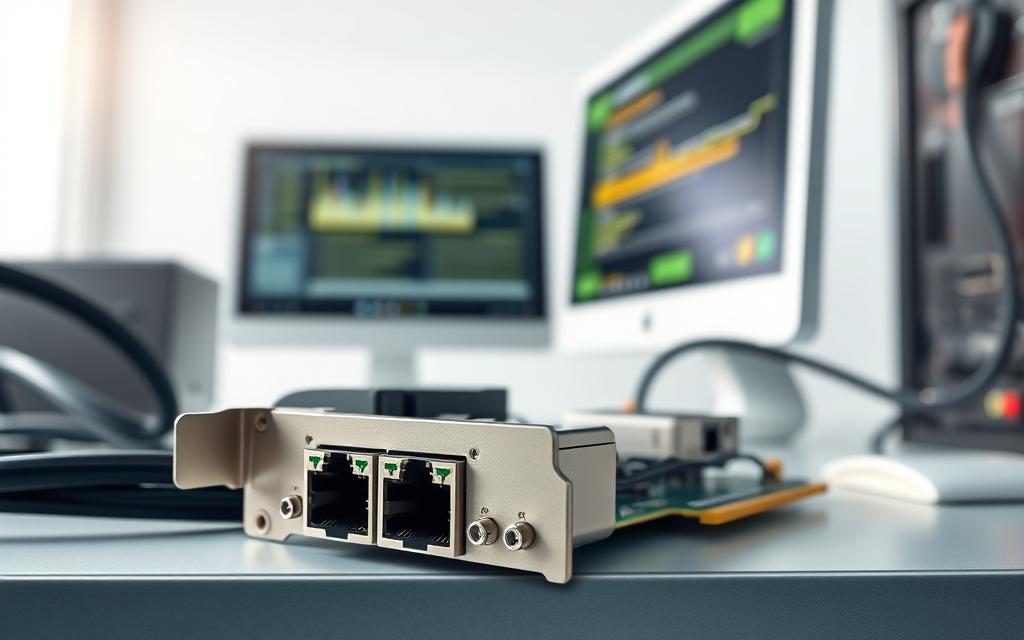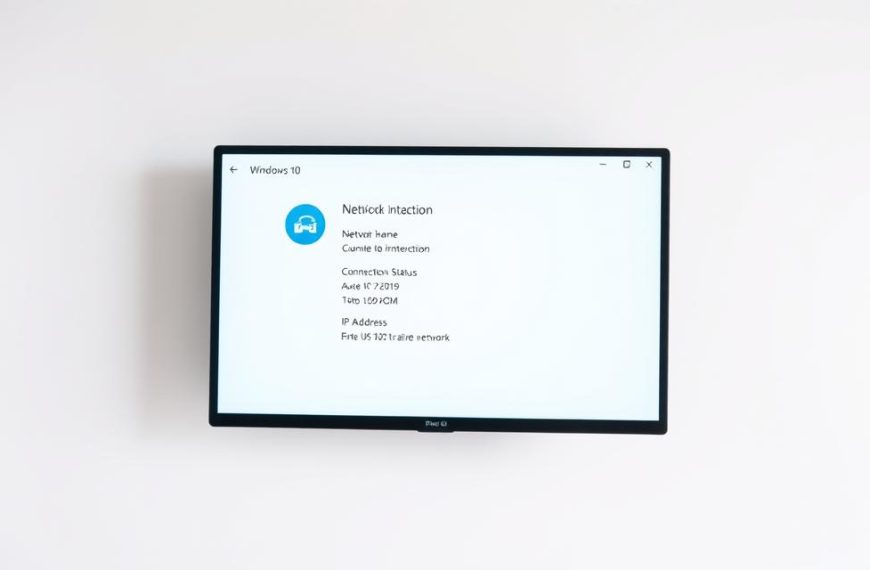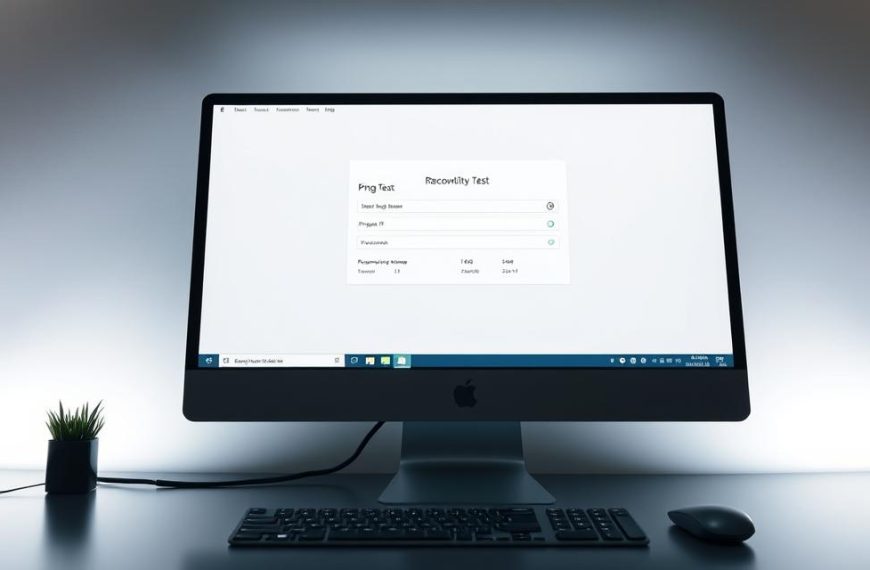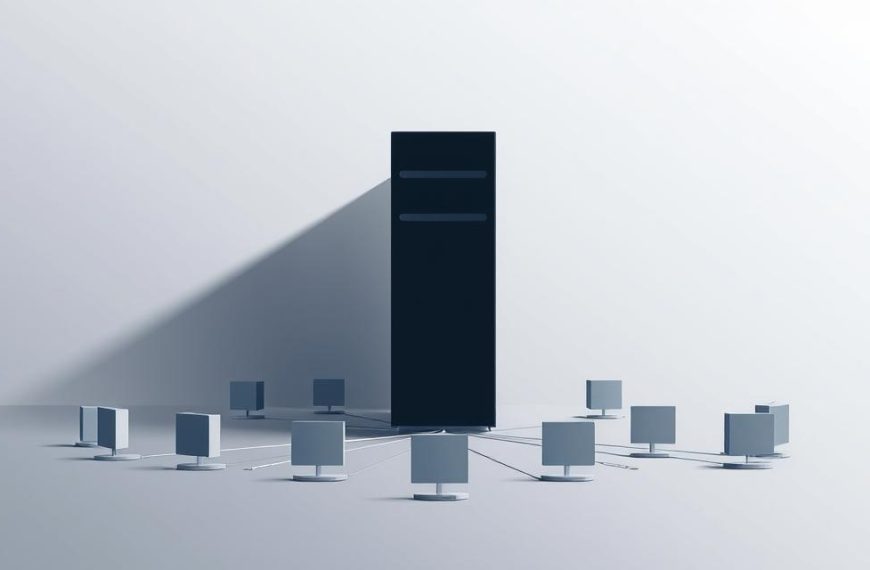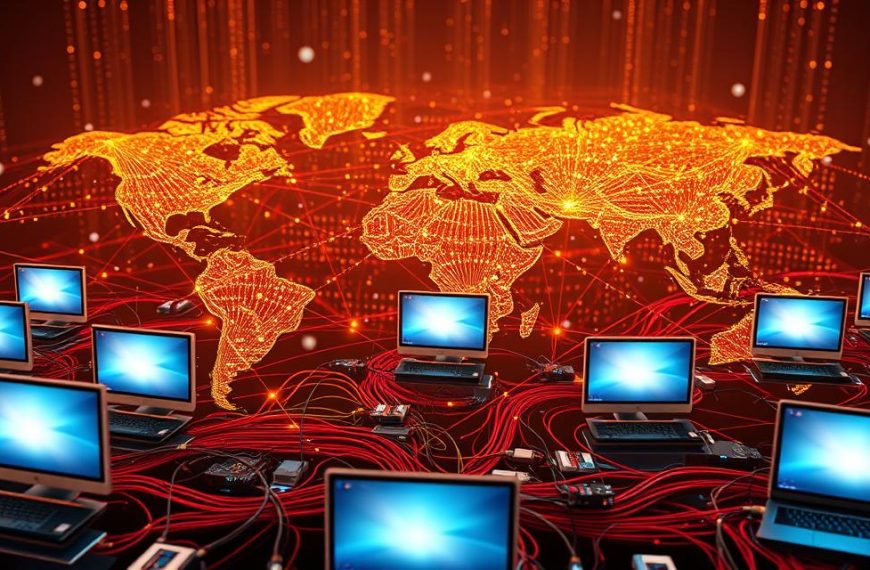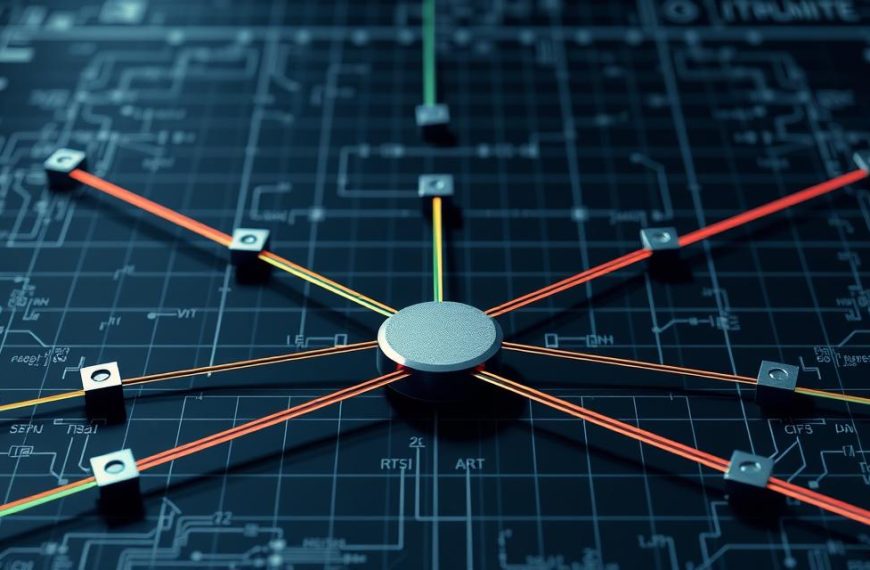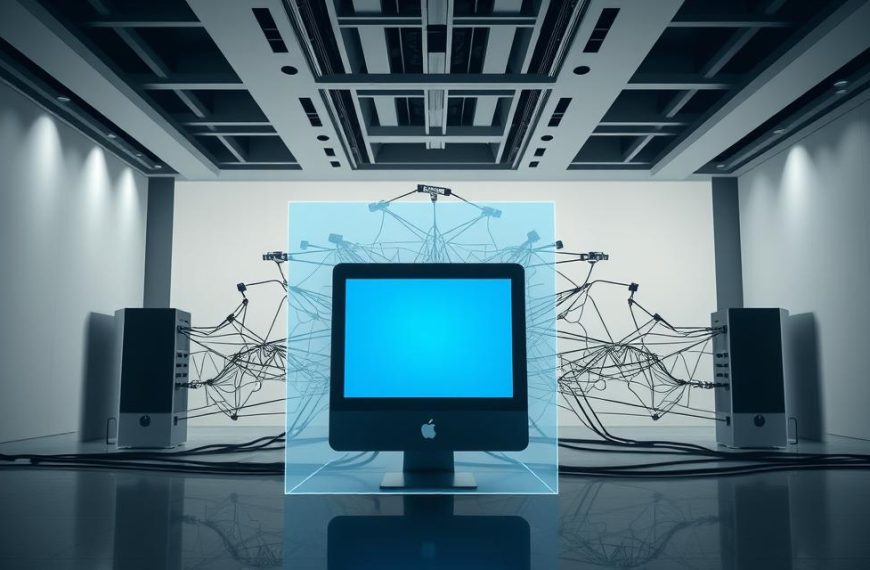A network interface card is key in linking your device to any network. It’s a vital part of computer networking hardware. It makes the physical connection needed for data exchange.
Also known as a network adapter or controller, its main job is to translate. It changes digital data from your computer into signals. These signals then travel over network cables or wirelessly.
This translation process allows for sharing resources and internet access. It works on local area networks (LANs) or broader systems. Knowing about the NIC meaning helps us understand today’s connectivity.
The technology has come a long way from older methods. It offers much faster speeds and more reliable performance for all devices on the network.
What is a NIC in Computer Network: Core Concepts and Definitions
The Network Interface Card is key in connecting devices to networks. It changes digital data into signals that can be sent. This shows why NICs are vital in today’s networks.
A main NIC function is handling data packets. It sends data out and gets data in. This is how NICs work in real life.
Another important job is changing data into signals. For wired connections, it turns data into electrical signals. For wireless, it becomes radio waves. This lets data move across networks.
NICs work in the OSI model layers, mainly at Layers 1 and 2. The Physical Layer deals with sending and receiving signals. The Data Link Layer formats frames and checks for errors.
Each NIC has a unique Media Access Control address. This address helps identify devices on a network. It’s used at the Data Link Layer.
| OSI Layer | Layer Name | NIC Functions | Key Responsibilities |
|---|---|---|---|
| Layer 1 | Physical Layer | Signal Conversion | Digital-to-analog conversion, signal transmission/reception |
| Layer 2 | Data Link Layer | Frame Management | Frame formatting, MAC addressing, error detection |
| Layer 3 | Network Layer | Packet Handling | IP addressing, packet routing assistance |
| Layer 4 | Transport Layer | Data Flow Control | Connection management, data segmentation |
Software drivers help the NIC talk to the operating system. They make sure the NIC works well with the OS. This is important for good performance.
Different types of connections need different NICs. Wired uses Ethernet and RJ-45, while wireless uses radio waves. Fibre optic needs special NICs with optical transceivers.
NICs do more than just connect devices. They manage traffic and check for errors. They also have features like quality of service and security. This makes them more than just simple connectors.
Primary Categories of Network Interface Cards
Network interface cards come in different types, each for specific needs. Knowing these helps professionals pick the right one for their networks.
Wired Ethernet Network Interface Cards
Wired Ethernet cards are the traditional choice for network connections. They use RJ-45 ports and cables for fast, reliable connections.
Found in desktops and servers, they offer steady performance with little interference. They’re great for places needing constant bandwidth and security.
Wireless Network Interface Controllers
Wireless controllers, or Wi-Fi adapters, offer cable-free connectivity. They use antennas and radio waves to connect to access points.
Working on 2.4GHz and 5GHz frequencies, they’re perfect for laptops and mobile devices. They keep you connected while you move around.
Specialised and Enterprise-grade NICs
For big networks, special NICs are needed. These cards handle tough tasks and unique needs.
Fibre optic NICs are fast for servers and data centres. There are PCI, PCI-X, and PCIe cards for different systems.
USB adapters are great for on-the-go connections. Mini PCIe cards fit small devices. Enterprise-grade cards are durable, have advanced features, and perform well.
| NIC Type | Primary Use Case | Connection Method | Typical Speed Range |
|---|---|---|---|
| Wired Ethernet | Desktops, Servers | RJ-45 Cable | 100 Mbps – 10 Gbps |
| Wireless Wi-Fi | Laptops, Mobile Devices | Radio Waves | 150 Mbps – 3 Gbps |
| Fibre Optic | Data Centres, Enterprise | Fibre Cable | 1 Gbps – 100 Gbps |
| USB Adapter | Portable Connectivity | USB Port | 100 Mbps – 2.5 Gbps |
“The right network interface card can dramatically impact overall system performance and connectivity reliability.”
Choosing the right NIC depends on your network needs, device type, and performance goals. Each type has its own role in today’s networks.
Operational Mechanics of Network Interface Cards
Network interface cards are more than just simple connectors. They are complex devices that enable devices to talk to each other and to networks. Their technical workings show the advanced engineering behind them.
Data Transmission and Reception Processes
At the heart of a NIC is the ability to turn digital data into signals that can be sent. When your computer sends data, the operating system sends it to the NIC.
The NIC then wraps this data in network frames. These frames include the source and destination addresses, the data itself, and a check for errors.
- Source and destination addresses
- Payload data
- Frame check sequence for error detection
This data transmission NIC process changes digital data into electrical signals. These signals then travel through cables to their destination.
Receiving data works the other way around. The NIC always checks the network for frames meant for it. When it finds one, it captures the signal.
It then changes the signal back into digital data. This data goes up to the operating system’s network stack. The whole process is fast and accurate.
MAC Address Allocation and Management
Every NIC has a unique identifier called a Media Access Control address. This MAC address is like a fingerprint for network devices.
The address is 48 bits long, split into two parts. The first 24 bits are the Organisationally Unique Identifier (OUI). The last 24 bits are unique to the device.
- First 24 bits: Organisationally Unique Identifier (OUI)
- Last 24 bits: Device-specific identifier
Manufacturers give these addresses out during production. The IEEE Registration Authority manages OUIs to keep addresses unique worldwide. This stops address conflicts on networks.
The MAC address is key for local network communication. Switches and bridges use these addresses to send frames to the right devices. Unlike IP addresses, MAC addresses work at the data link layer.
Protocol Stack Integration and Handling
NICs work closely with your operating system’s networking setup. This teamwork allows for advanced network protocol handling across different layers.
The NIC talks to protocol stacks through special drivers. These drivers help translate between hardware and system-level networking. When frames come in, the NIC alerts the CPU.
This alert helps the CPU process data efficiently. The operating system can then handle higher-level protocol tasks without constantly checking.
Error checking is another important task. Most NICs use Cyclic Redundancy Check algorithms. These algorithms check data integrity by spotting transmission errors.
Today’s NICs also have hardware acceleration. This feature helps the CPU by doing some tasks itself. This makes systems work better under heavy network use.
Critical Technical Specifications and Performance Indicators
Choosing the right network interface card (NIC) is key for top network performance. Its technical specs show how well it fits with your current setup and meets your data needs.
Speed Classifications and Bandwidth Capabilities
NICs come in various speeds to meet different needs. You’ll find 10/100/1000 Mbps for everyday use and 10 Gbps for high-speed needs.
Auto-negotiation lets NICs pick the best speed for both the card and network. This means you get the best performance without setting it manually.
The speed of a NIC affects how fast data moves. Faster NIC speed 100Mbps 1Gbps means quicker file sharing, smoother video, and better network speed.
Physical Interface Standards and Form Factors
NICs come in different shapes and sizes for different uses. Wired ones have RJ-45 ports, while wireless ones have antenna connectors.
Common types include:
- PCI Express (PCIe) cards for desktops
- USB adapters for on-the-go use
- Integrated controllers on motherboards
- Server-grade cards with lots of ports
These designs affect how well a NIC works with your computer and network.
Driver Compatibility and Operating System Support
NIC drivers are essential for hardware and software to talk. They manage data flow and settings.
Different NICs work with various operating systems. Most support:
- Windows 10 and 11
- Many Linux versions
- macOS
- Virtualisation environments
Keeping drivers up to date is important for security, better performance, and compatibility. Always check driver support before buying a NIC.
Leading Manufacturers and Their Product Ranges
The NIC market has top brands known for quality and reliability. They offer everything from basic adapters to high-end server cards.
Intel is famous for reliable Ethernet controllers. TP-Link makes affordable options, while ASUS focuses on gaming cards with extra features.
Cisco and Broadcom cater to businesses with high-performance cards. These have advanced features like hardware acceleration and better security.
When picking a NIC manufacturer, look at warranty, driver updates, and compatibility with your network gear.
Installation Procedures and Configuration Guidelines
Installing a network interface card needs careful steps. This guide will help you from start to finish. You’ll learn how to set it up and solve common problems.
Physical Installation Best Practices
Work in a place without static. Touch a metal part of the computer to ground yourself. Turn off your system and unplug all cables before installing an expansion card.
Find a PCI Express slot on your motherboard for modern NICs. Put the card in the slot carefully. Then, screw it to the chassis.
For built-in NICs, just plug in your network cable. Always check that cables are in right and secure when following a guide to install NIC hardware.
Software Configuration and Driver Management
Turn on your system after installing. Most systems will find new hardware automatically. But, for the best performance, install the latest drivers from the manufacturer’s website.
To set up your network adapter in Windows, go to Network and Sharing Centre. There, you can change IP addresses and DNS servers. Most users should choose “Obtain an IP address automatically.”
Managing drivers is key for stability. Update drivers regularly through your system’s device manager or the manufacturer’s site. Keep backups of working drivers for any issues.
Troubleshooting Common Connectivity Issues
Start with simple checks for network problems. Make sure cables are good and connected right. Also, check that lights are on for both the NIC and network switch.
Driver issues often cause problems. If your adapter stops working after updates, try going back to old drivers. You can do this in the device manager.
For ongoing issues, use built-in tools. Windows Network Diagnostics can help fix some problems. Tools like ipconfig and ping can test your connection.
| Symptom | Possible Cause | Recommended Action |
|---|---|---|
| No network connection | Faulty driver or physical connection | Reinstall drivers, check cables |
| Intermittent connectivity | Loose connection or overheating NIC | Reseat card, ensure proper ventilation |
| Slow transfer speeds | Outdated drivers or incorrect duplex settings | Update drivers, check adapter properties |
| Device not recognised | Faulty hardware or incompatible slot | Test in different slot, try another computer |
When troubleshooting NIC problems, keep a detailed record. This helps you find patterns and gives useful info for tech support. Some issues might need a pro’s help, like with business-grade hardware.
Conclusion
A Network Interface Card (NIC) is key for all network communication in computing devices. It connects devices, translates data, and gives each device a unique ID through MAC addresses. This is the base of modern networking. Knowing how NICs work is vital for everyone, from home users to IT experts.
Choosing the right NIC is important. You need to think about the type, specs, and how it works. Brands like Intel, TP-Link, and Broadcom have different options for various needs. This summary shows how picking the right NIC affects your network’s performance and reliability.
NICs are essential for both simple home internet and complex data centre operations. They make sure devices can talk to each other smoothly. This makes them a key part of digital connectivity plans for all kinds of computers.

